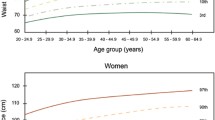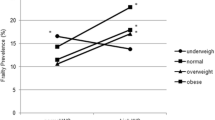Abstract
Background
There is an ongoing debate about the applicability of current criteria for large waist circumference (WC) in older adults.
Objectives
Our aim was to explore cut-off values for large WC in adults aged 70 years and older, using previously used and new methods.
Design
Prospective cohort study.
Participants
Data of 1049 participants of the Longitudinal Aging Study Amsterdam (LASA) (1995–1996), aged 70–88y, were used.
Measurements
Measured BMI and WC, and self-reported mobility limitations. Results Linear regression analyses showed that the values of WC corresponding to BMI of 25kg/m2 and 30kg/m2 were higher than the current cut-offs. Cut-offs found in men were 97 and 110cm, whereas 88 and 98cm represented the cut-offs in women. Areas under the Receiver Operating Characteristic (ROC) curves showed that the accuracy to predict mobility limitations improved when the higher cut-offs were applied. Spline regression curves showed that the relationship of WC with mobility limitations was U-shaped in men, while in women, the risk for mobility limitations increased gradually with increasing WC. However, at the level of current cut-off values for WC the odds for mobility limitations were not increased.
Conclusion
Based on results of extensive analyses, this study suggests that the cut-offs for large WC should be higher when applied to older adults. The association of WC with other negative health outcomes needs to be investigated to establish the final cut-points.
Similar content being viewed by others
References
Janssen I, Katzmarzyk PT, Ross R. Waist circumference and not body mass index explains obesity-related health risk. Am J Clin Nutr 2004 Mar;79(3):379–384.
Zhu S, Wang Z, Heshka S, et al. Waist circumference and obesity-associated risk factors among whites in the third National Health and Nutrition Examination Survey: clinical action thresholds. Am J Clin Nutr 2002 Oct;76(4):743–749.
Chen H, Guo X. Obesity and functional disability in elderly Americans. J Am Geriatr Soc 2008 Apr;56(4):689–694.
Guallar-Castillon P, Sagardui-Villamor J, Banegas JR, et al. Waist Circumference as a Predictor of Disability among Older Adults. Obesity, 2007;15(1):233–244.
Lean ME, Han TS, Morrison CE. Waist circumference as a measure for indicating need for weight management. BMJ 1995 Jul 15;311(6998):158–161.
Heiat A, Vaccarino V, Krumholz HM. An evidence-based assessment of federal guidelines for overweight and obesity as they apply to elderly persons. Arch Intern Med 2001 May 14;161(9):1194–1203.
WHO Consultation on obesity. Obesity: Preventing and Managing the Global Epidemic Geneva: World Health Organization, Division of Noncommunicable Diseases, Programme of Nutrition, Family and Reproductive Health, 1998.
Visscher TL, Seidell JC, Molarius A, et al. A comparison of body mass index, waist-hip ratio and waist circumference as predictors of all-cause mortality among the elderly: the Rotterdam study. Int J Obes Relat Metab Disord 2001 Nov;25(11):1730–1735.
Molarius A, Seidell JC, Visscher TL, et al. Misclassification of high-risk older subjects using waist action levels established for young and middle-aged adults—results from the Rotterdam Study. J Am Geriatr Soc 2000 Dec;48(12):1638–1645.
Snijder MB, van Dam RM, Visser M, et al. What aspects of body fat are particularly hazardous and how do we measure them? Int J Epidemiol, 2006;35(1):83–92.
Netuveli G, Wiggins RD, Hildon Z, et al. Quality of life at older ages: evidence from the English longitudinal study of aging (wave 1). J Epidemiol Community Health 2006 Apr;60(4):357–363.
Okosun IS, Tedders SH, Choi S, et al. Abdominal adiposity values associated with established body mass indexes in white, black and hispanic Americans. A study from the Third National Health and Nutrition Examination Survey. Int J Obes Relat Metab Disord 2000 Oct;24(10):1279–1285.
Woo J, Ho SC, Yu AL, et al. Is waist circumference a useful measure in predicting health outcomes in the elderly? Int J Obes Relat Metab Disord 2002 Oct;26(10):1349–1355.
Deeg DJH, Westendorp-de Serière M. Autonomy and well-being in the aging population; Report from the longitudinal Aging Study Amsterdam 1992–1993. Amsterdam: VU University Press, 1994.
Deeg DJ, van Tilburg T, Smit JH, et al. Attrition in the Longitudinal Aging Study Amsterdam. The effect of differential inclusion in side studies. J Clin Epidemiol 2002 Apr;55(4):319–328.
Stel VS, Smit JH, Pluijm SM, et al. Comparison of the LASA Physical Activity Questionnaire with a 7-day diary and pedometer. J Clin Epidemiol 2004 Mar;57(3):252–258.
Kriegsman DM, Penninx BW, van Eijk JT, et al. Self-reports and general practitioner information on the presence of chronic diseases in community dwelling elderly. A study on the accuracy of patients’ self-reports and on determinants of inaccuracy. J Clin Epidemiol 1996 Dec;49(12):1407–1417.
Burnham KP, Anderson DR. Model selection and multimodel inference: a practical information-theoretic approach, 2 Ed. New York: Springer, 2002.
Steenland K, Deddens JA. A practical guide to dose-response analyses and risk assessment in occupational epidemiology. Epidemiology 2004 Jan;15(1):63–70.
Akaike H. A New Look at the Statistical Model Identification. IEEE Trans Autom Control 1974 December 1974;19(6):716–723.
Lemieux S, Prud’homme D, Bouchard C, et al. A single threshold value of waist girth identifies normal-weight and overweight subjects with excess visceral adipose tissue. Am J Clin Nutr 1996 Nov;64(5):685–693.
Zamboni M, Mazzali G, Zoico E, et al. Health consequences of obesity in the elderly: a review of four unresolved questions. Int J Obes 2005 Sep;29(9):1011–1029.
LaCroix AZ, Guralnik JM, Berkman LF, et al. Maintaining mobility in late life. II. Smoking, alcohol consumption, physical activity, and body mass index. Am J Epidemiol 1993 Apr 15;137(8):858–869.
Launer LJ, Harris T, Rumpel C, et al. Body mass index, weight change, and risk of mobility disability in middle-aged and older women. The epidemiologic follow-up study of NHANES I. JAMA 1994 Apr 13;271(14):1093–1098.
Visser M, Langlois J, Guralnik JM, et al. High body fatness, but not low fat-free mass, predicts disability in older men and women: the Cardiovascular Health Study. Am J Clin Nutr 1998 Sep;68(3):584–590.
Laukkanen P, Heikkinen E, Kauppinen M. Muscle strength and mobility as predictors of survival in 75–84-year-old people. Age Ageing 1995 Nov;24(6):468–473.
Rolland Y, Lauwers-Cances V, Cesari M, et al. Physical performance measures as predictors of mortality in a cohort of community-dwelling older French women. Eur J Epidemiol 2006;21(2):113–122.
Author information
Authors and Affiliations
Corresponding author
Rights and permissions
About this article
Cite this article
Heim, N., Snijder, M.B., Heymans, M.W. et al. Exploring cut-off values for large waist circumference in older adults: A new methodological approach. J Nutr Health Aging 14, 272–277 (2010). https://doi.org/10.1007/s12603-010-0060-7
Received:
Accepted:
Published:
Issue Date:
DOI: https://doi.org/10.1007/s12603-010-0060-7




